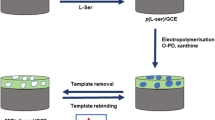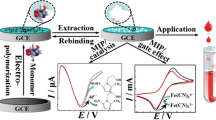Abstract
The authors report on a ratiometric electrochemical sensor for paracetamol (PR) which was fabricated by successively electropolymerizing a layer of Prussian blue (PB) and a layer of molecularly imprinted polypyrrole (MIP) on the surface of a glassy carbon electrode (GCE). The binding of PR molecules to the MIP has two effects: The first is an increase of the oxidation current for PR at 0.42 V (vs. SCE), and the second is a decrease in the current for PB (at 0.18 V) due to partial blocking of the channels which results in reduced electron transmissivity. Both currents, and in particular their ratio, can serve as analytical information. Under optimized conditions, the sensor displays enhanced sensitivity for PR in the 1.0 nM to 0.1 mM concentration range and a 0.53 nM lower limit of detection. The sensor was applied to the determination of PR in tablets and urines where it gave recoveries in the range between 94.6 and 104.9 %. This dual-signal (ratiometric) detection scheme (using electropolymerized Prussian Blue and analyte-specific MIP) in our perception has a wide scope in that it may be applied to numerous other electroactive species for which specific MIP can be made available.

Prussian blue (PB) and molecularly imprinted polymer (MIP) were combined to fabricate an electrochemical sensor for paracetamol (PR) detection. The ratio of both currents, increase of PR current and decrease of PB current, was employed for PR selective detection with enhanced sensitivity.





Similar content being viewed by others
References
Wulff G (2013) Forty years of molecular imprinting in synthetic polymers: Origin, features and perspectives. Microchim Acta 180:1359–1370
Iacob BC, Bodoki E, Florea A (2015) Simultaneous Enantiospecific Recognition of Several β-Blocker Enantiomers Using Molecularly Imprinted Polymer-Based Electrochemical Sensor. Anal Chem 87:2755–2763
Gam-Derrouich BSC, Marcillac WDD, Coolen L, Maitre A, Mangeney C, Schwob C (2015) Quantum dot-imprinted polymers with size and shell-selective recognition properties. Chem Commun 51:14933–14936
Awino JK, Zhao Y (2014) Molecularly imprinted nanoparticles as tailor-made sensors for small fluorescent molecules. Chem Commun 50:5752–5755
Shi HJ, Zhao GH,mailto: ghzhao.tongji@hotmail.com Liu MC, Zhu ZL (2011) A novel photoelectrochemical sensor based on molecularly imprinted polymer modified TiO2 nanotubes and its highly selective detection of 2,4-dichlorophenoxyacetic acid. Electrochem Commun 13: 1404–1407
N. Karimiana N, Zavarb MHA, Chamsazb M, Turnera APF, Tiwari A (2013) On/off-switchable electrochemical folic acid sensor based on molecularly imprinted polymer electrode. Electrochem Commun 36:92–95
Markas AT (1994) Rapid detection of paracetamol using a disposable, surface-modified screen-printed carbon electrode. Analyst 119:2431–2437
Shiroma LY, Santhiago M, Gobbi AL, Kubota LT (2012) Separation and electrochemical detection of paracetamol and 4-aminophenol in a paper-based microfluidic device. Anal Chim Acta 725:44–50
Santos EDB, Lima ECNL, Oliveira CSD, Sigoli FA, Mazali IO (2014) Fast detection of paracetamol on a gold nanoparticle–chitosan substrate by SERS. Anal Methods 6:3564–3568
Ruiz-Medina A, Córdova MFL, Ayora-Cañada MJ, Pascual-reguera MI, Molina-Díaz A (2000) A flow-through solid phase UV spectrophotometric biparameter sensor for the sequential determination of ascorbic acid and paracetamol. Anal Chim Acta 404:131–139
Easwaramoorthy D, Yu Y-C, Huang H-J (2001) Chemiluminescence detection of paracetamol by a luminol-permanganate based reaction. Anal Chim Acta 439:95–100
Rafael RC, Chaves SC, Ribeiro MMAC, Pascual-reguera MI, Molina-Díaz AJ (2015) Simultaneous determination of caffeine, paracetamol, and ibuprofen in pharmaceutical formulations by high-performance liquid chromatography with UV detection and by capillary electrophoresis with conductivity detection. J Sep Sci 38:1657–1662
Lentini G, Habtemariam S (2014) Microchip capillary electrophoresis–electrospray ionization mass spectrometry analysis of paracetamol metabolites in human urine: An intriguing case. J Chromatogr A 1327:160
Li JH, Liu JL, Tan GG, Jiang JB, Peng SJ, Deng M, Qian D, Feng YL, Liu YC (2014) High-sensitivity paracetamol sensor based on Pd/graphene oxide nanocomposite as an enhanced electrochemical sensing platform. Biosens Bioelectron 54:468–475
Kalambate PK, Sanghavi BJ, Karna SP, Srivastava AK (2015) Simultaneous voltammetric determination of paracetamol and domperidone based on a graphene/platinum nanoparticles/nafion composite modified glassy carbon electrode. Sensors Actuators B Chem 213:285–294
Li L-L, Zhou T-T, Sun GY, Li ZH, Yang WX, Jia JB, Yang GC (2015) Ultrasensitive electrospun nickel-doped carbon nanofibers electrode for sensing paracetamol and glucose. Electrochim Acta 152:31–37
Luo J, Cong J, Fang R, Fei X, Liu X (2014) One-pot synthesis of a graphene oxide coated with an imprinted sol–gel for use in electrochemical sensing of paracetamol. Microchim Acta 181:1257–1266
Liu X, Zhang XY, Wang LL, Wang YY (2014) A sensitive electrochemical sensor for paracetamol based on a glassy carbon electrode modified with multiwalled carbon nanotubes and dopamine nanospheres functionalized with gold nanoparticles. Microchim Acta 181:1439–1446
Teng Y, Fan LM, Dai YL, Zhong M, Lu XJ, Kan XW (2015) Electrochemical sensor for paracetamol recognition and detection based on catalytic and imprinted composite film. Biosens Bioelectron 71:137–142
Liu R, Zeng X, Liu J, Luo J, Zheng Y, Liu X (2016) A glassy carbon electrode modified with an amphiphilic, electroactive and photosensitive polymer and with multi-walled carbon nanotubes for simultaneous determination of dopamine and paracetamol. Microchim Acta 183:1543–1551
Gómez-Caballero A, Goicolea MA, Barrio RJ (2005) Paracetamol voltammetric microsensors based on electrocopolymerized–molecularly imprinted film modified carbon fiber microelectrodes. Analyst 130:1012–1018
Wang CH, Li CY, Wei LF, Wang CF (2007) Electrochemical sensor for acetaminophen based on an imprinted TiO2 thin film prepared by liquid phase deposition. Microchim Acta 158:307–313
Özcan L, Şahin Y (2007) Determination of paracetamol based on electropolymerized-molecularly imprinted polypyrrole modified pencil graphite electrode. Sensors Actuators B Chem 127:362–369
Chuang S-W, Rick J, Chou T-C (2009) Electrochemical characterisation of a conductive polymer molecularly imprinted with an Amadori compound. Biosens Bioelectron 24:3170–3173
Azevado SD, Lakshmi D, Chianella I, Whitcombr MJ, Karim K, Ivanova-Mitseve PK, Subrhmanyam S, Piletsky SA (2013) Molecularly imprinted polymer-hybrid electrochemical sensor for the detection of β-estradiol. Ind Eng Chem Res 52:13917–13923
Huynh T-P, Sosnowska M, Sobczak JW, Chandra BKC, Nesterov VN, D’Souza F, Kutner W (2013) Simultaneous chronoamperometry and piezoelectric microgravimetry determination of nitroaromatic explosives using molecularly imprinted thiophene polymers. Anal Chem 85:8361–8368
Lattach Archirel P, Remita S (2012) Influence of the chemical functionalities of a molecularly imprinted conducting polymer on its sensing properties: electrochemical measurements and semiempirical DFT calculations. J Phys Chem B 116:1467–1481
Karyakin AA (2001) Prussian blue and its analogues: electrochemistry and analytical applications. Electroanalysis 13:813–819
Seeber R, Totir N, Zanardi C (2002) Electrochemical preparation and characterisation of bilayer films composed by Prussian Blue and conducting polymer. Electrochem Commun 4:753–758
Li JP, Li YP, Zhang Y, Wei G (2012) Highly Sensitive Molecularly imprinted electrochemical sensor based on the double amplification by an inorganic Prussian Blue catalytic polymer and the enzymatic effect of glucose oxidase. Anal Chem 84:1888–1893
Li YX, Li YJ, Hong M, Bin Q, Lin ZY, Lin Z, Cai ZW, Chen GN (2013) Highly sensitive protein molecularly imprinted electro-chemical sensor based on gold microdendrites electrode and prussian blue mediatedamplification. Biosens Bioelectron 42:612–617
Cui M, Liu S, Lian WJ, Li J, Xu W, Huang JD (2013) A molecularly-imprinted electrochemical sensor based on a graphene–Prussian blue composite-modified glassy carbon electrode for the detection of butylated hydroxyanisole in foodstuffs. Analyst 138:5949–5955
Yang YK, Cao YY, Wang XM, Fang GZ, Wang S (2015) Prussian blue mediated amplification combined with signal enhancement of ordered mesoporous carbon for ultrasensitive and specific quantification of metolcarb by a three-dimensional molecularly imprinted electrochemical sensor. Biosens Bioelectron 64:247–254
Frasconi M, Tel-Vered R, Riskin M, Willner I (2010) Surface Plasmon resonance analysis of antibiotics using imprinted boronic acid-functionalized Au nanoparticles composites. Anal Chem 82:2512–2519
Rezaei B, Boroujeni MK, Ensafi AA (2015) Fabrication of DNA, o-phenylenediamine, and gold nanoparticle bioimprinted polymer electrochemical sensor for the determination of dopamine. Biosens Bioelectron 66:490–496
Zhong M, Teng Y, Pang S, Yan L, Kan X (2015) pyrrole-phenylboronic acid: a novel monomer for dopamine recognition and detection based on imprinted electrochemical sensor. Biosens Bioelectron 64:212–218
Xia J, Cao X, Wang Z, Yang M, Zhang F, Lu B, Li F, Xia L, Li Y, Xia Y (2016) Molecularly imprinted electrochemical biosensor based on chitosan/ionic liquid-graphene composites modified electrode for determination of bovine serum albumin. Sensors Actuators B Chem 225:305–311
Li BL, Luo JH, Luo HQ, Li NB (2013) A novel strategy for the selective determination of D-penicillamine based on molecularly imprinted polypyrrole electrode via the electrochemical oxidation with ferrocyanide. Sensors Actuators B Chem 186:96–102
Ramanavičius A, Ramanavičienė A, Malinauskas A (2006) Electrochemical sensors based on conducting polymer-pyrrole. Electrochim Acta 51:6025–6037
Suryanarayanan V, Wu C-T, Ho K-C (2010) Molecularly imprinted electrochemical sensors. Electroanalysis 22:1795–1811
Sitnikova NA, Komkova MA, Khomyakova IV, Karyakina EE, Karyakin AA (2014) Transition metal hexacyanoferrates in electrocatalysis of H2O2 reduction: An exclusive property of Prussian Blue. Anal Chem 86:4131–4134
Zhang Y, Sun XM, Zhu LZ, Shen HB, Jia NQ (2011) Electrochemical sensing based on graphene oxide/Prussian blue hybrid film modified electrode. Electrochim Acta 56:1239–1245
Li NB, Park JH, Park K, Kwon JS, Shin H, Kwak J (2008) Characterization and electrocatalytic properties of Prussian blue electrochemically deposited on nano-Au/PAMAM dendrimer-modified gold electrode. Biosens Bioelectron 23:1519–1526
Ricci F, Goncalves C, Amine A, Gorton L, Palleschi G, Moscone D (2003) Electroanalytical study of Prussian Blue modified glassy carbon paste electrodes. Electroanalysis 15:1204–1211
Jiang YY, Zhang XD, Shan CS, Hua SC, Zhang QX, Bai XX, Dan L, Niu L (2011) Functionalization of graphene with electrodeposited Prussian blue towards amperometric sensing application. Talanta 85:76–81
Adhikari B-R, Govindhan M, Chen A (2015) Sensitive Detection of acetaminophen with graphene-based electrochemical sensor. Electrochim Acta 162:198–204
Mao AR, Li HB, Jin DQ, Yu LY, Hu XY (2015) Fabrication of electrochemical sensor for paracetamol based on multi-walled carbon nanotubes and chitosan–copper complex by self-assembly technique. Tanalta 144:252–257
Acknowledgments
We greatly appreciate the support of the National Natural Science Foundation of China (21575003), Anhui Provincial Natural Science Foundation for Young Program (11040606Q35).
Author information
Authors and Affiliations
Corresponding author
Ethics declarations
The author(s) declare that they have no competing interests.
Electronic supplementary material
ESM 1 Electronic Supplementary Material
(DOC 506 kb)
Rights and permissions
About this article
Cite this article
Dai, Y., Li, X., Lu, X. et al. Voltammetric determination of paracetamol using a glassy carbon electrode modified with Prussian Blue and a molecularly imprinted polymer, and ratiometric read-out of two signals. Microchim Acta 183, 2771–2778 (2016). https://doi.org/10.1007/s00604-016-1926-0
Received:
Accepted:
Published:
Issue Date:
DOI: https://doi.org/10.1007/s00604-016-1926-0




